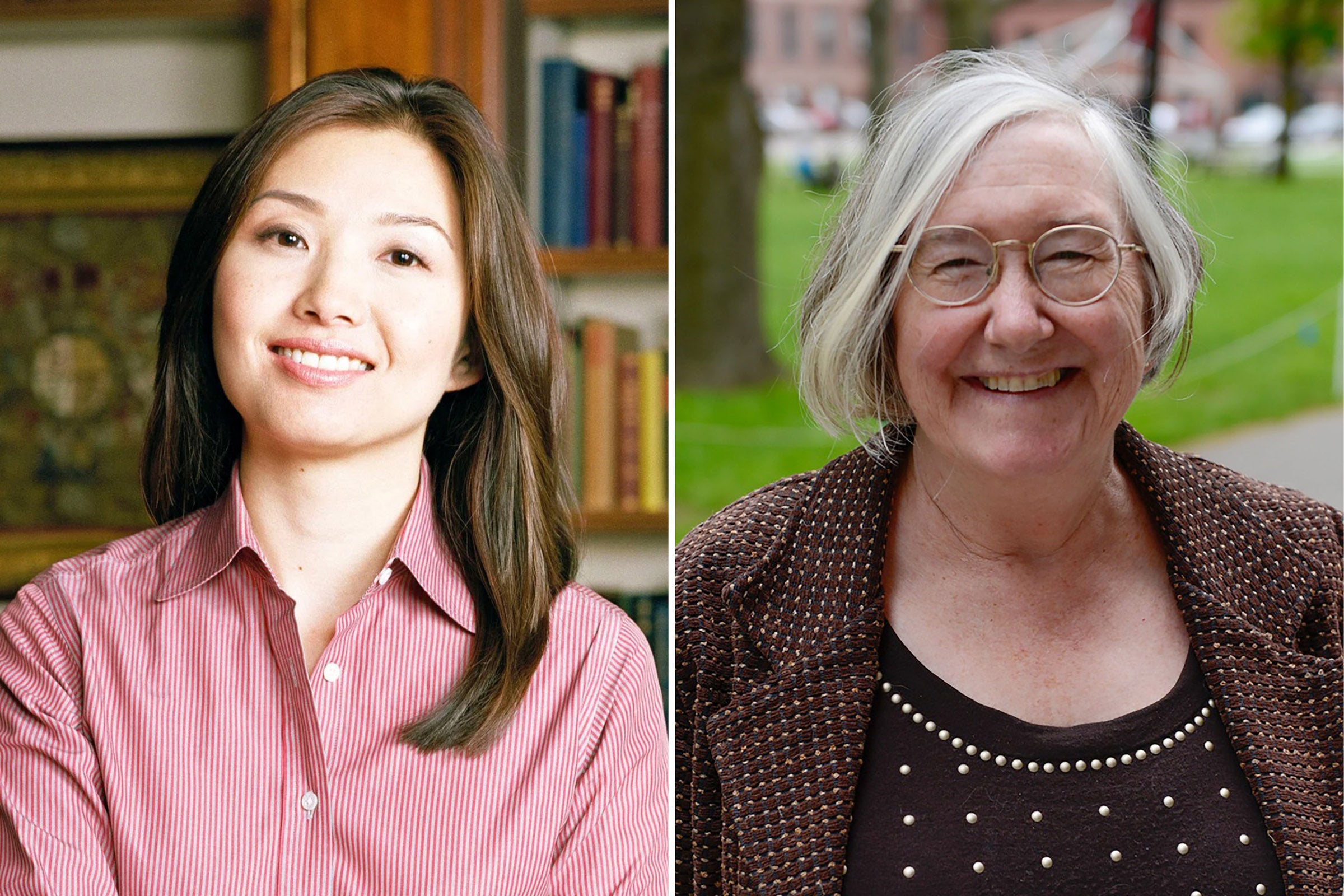The Academic Freedom Alliance is a non-profit organization whose mission is to uphold the principles of academic freedom for faculty members at colleges and universities in the United States. The ideologically diverse group is committed to protecting the right to speak, instruct, and publish without fear of sanction or punishment. Founded in 2021, it has grown to include nearly 700 faculty members, including eleven at Harvard Law School: Elizabeth Bartholet ’65, Charles Fried, Jesse Fried ’92, Jack Goldsmith, David W. Kennedy, Randall L. Kennedy, Richard Parker ’70, Ronald S. Sullivan, Jr. ’94, and Dehlia Umunna.
Harvard Law Professor Janet Halley, the Eli Goldston Professor of Law, currently serves as chair of AFA’s Academic Committee, which includes HLS Visiting Professor Robert George ’81. Jeannie Suk Gersen ’02, the John H. Watson, Jr. Professor of Law at Harvard, is a member of AFA’s Legal Advisory Council, along with Harvard Law alumni Paul Clement ’92, Elizabeth Cosenza ’01, Nadine Strossen ’75 and Stephen T. Whelan ’71.
Harvard Law Today recently asked Halley and Gersen about why they think academic freedom is under threat and what they hope to do about it.

What is the Academic Freedom Alliance?
Janet Halley: The Academic Freedom Alliance is a nonprofit legal defense fund. It’s a membership organization with upwards of 700 faculty members. … We protect the rights of faculty members at colleges and universities to speak, instruct and publish without fear of sanction or punishment. In a time when calls from both the right and the left for such sanctions and punishment are not lacking, we are ideologically agnostic. We have an ideologically diverse membership and we’re committed to defending the academic freedom and free speech of faculty members without regard to the ideological content of the speech. … It’s about protecting the pursuit of knowledge, and fostering an atmosphere at colleges and universities in which ideas can be followed without fear that you’ll be punished.
What kind of support do you provide?
Halley: As a legal defense fund, we have committed to our members that if they are ever disciplined for an exercise of academic freedom — or, for those working at public institutions, for an exercise of constitutionally protected free speech — we will provide lawyering money for them to defend their case. … Other arrows in our quiver include private letters to the administrators involved in proceedings against a faculty member. We also issue public statements which are readily accessible on the AFA website. We work with members who are having these problems to decide what the appropriate response is.
How did you get involved?
Halley: Jeannie and I got involved more than a year ago when the originating group, which is mostly Princeton professors, reached out to us. We’ve been working with them to build the organization, to help figure out how to structure it, and to make sure that it stays within its mission and maintains its commitment to ideological diversity.
There’s a committee called the academic committee, which is made up entirely of professors, with a very teeny administrative staff of one person, who make the preliminary decision in all cases that come to our attention. I’m the chair of that. … And then there’s a lawyering committee where decisions to actually take legal action are made. Jeannie is on that committee, so we both have leadership roles in the organization.
Why is the Academic Freedom Alliance needed?
Gersen: Even in the recruitment process, the organization encountered exactly this issue: ‘What does it mean for me to join an organization called the Academic Freedom Alliance? What does that communicate about who I am? And does that itself put me at risk? What if people think I favor the free speech of people I consider despicable?’ And if you look at our membership list, and at some of the things that the Academic Freedom Alliance has defended, it is a feature, not a bug, that some of the speech and the people who are defended, are ones that you might find repulsive. … If you, as a faculty member, don’t want to be associated with speech that you really disagree with or think is just despicable, then you’re not going to be willing to join. But the idea of the Alliance is that the attacks on academic freedom really do span the ideological spectrum. And that’s why this coalition is about protecting the idea of academic freedom and not about the speech of one side or the other side.
“The idea of the Academic Freedom Alliance is that attacks on academic freedom really do span the ideological spectrum. … This coalition is about protecting the idea of academic freedom and not about the speech of one side or the other side.”
Jeannie Suk Gersen
What do you see as among the biggest threats in this moment to academic freedom?
Halley: One of the biggest threats is the effect these calls for silencing objectionable positions on the right or left have on students’ attitudes towards the classroom. Many teachers today perceive the students as withdrawn and unwilling to engage and writing cautiously, as opposed to experimenting with ideas. It’s a whole new challenge of its own to teach in such a way that students can speak in an experimental and probing way in class. I think that the effect on the learning experience is profound. And so, although we are a faculty organization, there are huge implications for students in maintaining a commitment to teachers’ academic freedom, because doing so can create academic freedom for students.
Gersen: This is really about looking at the bigger picture systemic effects of what it would mean for people to be chilled in an academic setting. At its best, academic freedom involves experimentation — the freedom to explore things that are unknown and uncertain, and to try out ideas that you may later revisit and think of as wrong, or that may get you on a path to something new and different altogether. I think that’s really the wonderful project of a university. And when we see the chilling effect on that process, we feel saddened and we want to do something about it.
Last August, AFA criticized institutions of higher education for requiring diversity, equity and inclusion statements for faculty as conditions of employment or promotion. Why?
Gersen: Candidates for employment, promotion, or tenure are sometimes required to provide a [diversity, equity and inclusion] statement. You can’t say in the statement, ‘I never really think about diversity and inclusion. I’m a scientist working on X,Y, and Z, and I just do my science and I don’t discriminate. That’s my commitment.’ This is not really the kind of DEI statement that is envisioned by institutions that are requiring every candidate to write one. Instead, they are more like loyalty oaths or ideological purity tests that you have to take in order to prove that you are worthy of being promoted or hired. I think it was important for us to put out a statement, ourselves, just saying that’s not consistent with academic freedom.
Are these required statements relatively recent?
Halley: Yes, it’s definitely the institutionalization of a social justice vision that was intensified so dramatically in the post George Floyd era. And some of those social justice ideas have been operationalized into diversity, equity, and inclusion statements required of faculty members at the time of hiring or promotion. You see some institutions saying, ‘Well, how can we prove that we’re good on those issues? Oh, let’s require statements.’ And so, it’s not a statement of the institution. If the institution wants to commit itself to values, that’s fine. But if it wants to require other people to commit themselves to values that aren’t relevant to the academic mission, we think that’s deeply problematic.
There must be challenges inherent to creating an alliance across ideological differences. How do you decide what to take on or defend?
Gersen: That challenge is baked into the enterprise and its initiation. And it’s something that we have been thinking about since day one, and we think about it every day. It’s inherently challenging. It sometimes feels like a tightrope, because we live in a society and a university that have to set boundaries, and there are offenses for which one could be disciplined or punished. Right now, I’m mainly focused in my own writing and thinking about the issue of discrimination and what it means to discriminate. Discrimination might be an action, like excluding a person from a class or an educational opportunity, because they are a certain race or gender. That’s a very clear example of discrimination. But verbal utterances can also be discriminatory and result in discipline. We’re not here to say that if it comes out of your mouth, or out of your pen, in the form of words, that it is, by definition, not discriminatory. We don’t think that. The mission statement does recognize that just because you say it, that doesn’t insulate you from the charge of having violated a rule against discrimination. And so, the distinction between academic freedom and discrimination is not a simplistic or straightforward distinction all the time.
Halley: On the academic committee, we try not to get into mission creep. When people ask us to take up cases in which there’s some marginal issue of speech or academic freedom, but a core issue of professional standards, compliance with the sexual harassment policy, or compliance with requirements against discrimination, we are committed to sorting through these questions.
The other hard thing that’s difficult for me personally is, when we have to defend somebody who I really, really disagree with, I can’t do my AFA role and then post something on my website of saying, ‘Oh, I really hate what that person wrote.’ I have to stand out in public being associated with somebody whose speech I find really, really problematic. … But that’s one of the things that goes with protecting academic freedom. A freedom of speech organization must work on an ideologically diverse basis; it just goes with the territory.
Gersen: What Janet said is right, but I think it has a lot to do with her important leadership role in the organization. I could envision two members of the organization being diametrically on different sides of an issue and going at it in public in terms of their own arguments and debates, without the dispute tearing the organization apart. This is just part of what it means to have a coalition where we expect that members will be very different in how they think about the important issues in our society.
Halley: That’s right.
